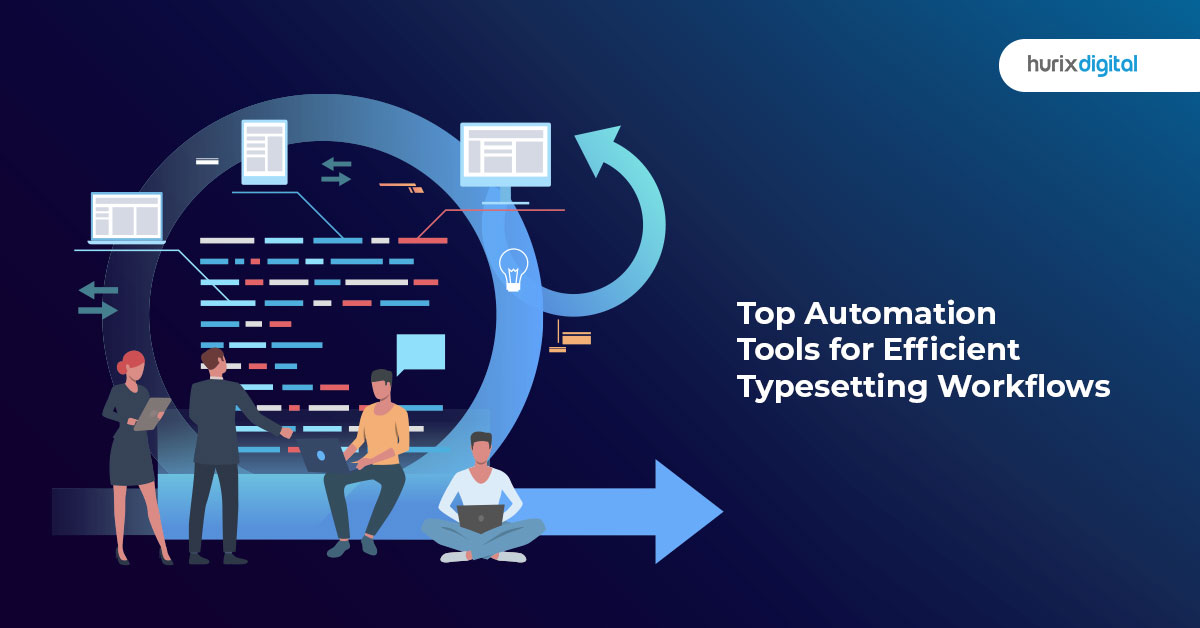Top Automation Tools for Efficient Typesetting Workflows
Over the last couple of years, the publishing domain has experienced a host of changes. For an instant, there is a growing demand for audiobooks and ebooks. K12 education is moving from paper textbooks to interactive digital books. Technology is also enhancing the way scientific journals are being published, due to improved language capabilities, among others.
Another key trend is the increased adoption of workflow automation tools, which enable publishers to bring more efficiency to pre-press processes such as typesetting. By 2030, the global typesetting software market is projected to grow to $2.06 billion from a market size of $1.02 billion in 2017, at a compound annual growth rate of 7.5%.
In this blog, we explore what typesetting is, the key benefits of adopting automation software, and the top tools available.
Table of Contents:
- What is Typesetting?
- Challenges with Traditional Typesetters
- Benefits of Automated Typesetting Tools
- Best Workflow Automation Tools for Typesetting
- Conclusion
What is Typesetting?
“What is a typesetter?” is a common question asked by any business looking to publish content in the form of eBooks, slideshows, paper books, and scientific journals.
This is essentially a tool used to help simplify the process of typesetting, an important step that is a part of the publishing work cycle. A typesetting tool enables designers and content creators to format the text, images, and other types of content, in a systematic, appealing, and highly readable manner.
Today, there is a trend of businesses making a transition from using traditional print-based typesetting tools to digital typesetting tools that completely automate the process. Workflow automation tools examples that help simplify typesetting include LaTeX and Manuscripts.
Also Read: The Role of Interior Design in Typesetting and Layout Design in InDesign
Challenges with Traditional Typesetters
Traditionally, the entire publishing work cycle typesetting process is manual and cumbersome. Typesetting requires immense attention to detail, creativity, and adherence to basic hygiene practices.
Publishers needed to hire several professional designers to execute the typesetting process end-to-end, especially for scientific journals. This required significant investment in human resources. The design process required a lot of basic formatting to be done from scratch, leaving limited scope and time to elevate the design aesthetics to another level.
However, the biggest challenge is the inability of editors, authors, and designers to collaborate seamlessly. This is because typesetting systems did not have access to a cloud-based unified interface where all collaborators could be onboarded onto one platform.
Hence, the entire pre-press process would take longer due to multiple reworks and a lack of access to real-time changes.
Today, typesetting automation companies are changing the narrative.
Benefits of Automated Typesetting Tools
The shift to automated typesetting tools offers multiple advantages to businesses looking to bring in more efficiency and scale their business:
- Traditionally, typesetting is a highly labor-intensive effort. Publishing workflow automated tools help companies reduce manual efforts.
- The overall output quality is enhanced as automated workflow tools offer multiple templates and customization options to raise the publication standard.
- Such tools enable easy collaboration between various project teams across geographies.
- Businesses can expedite the production process and take their products to market faster, thus giving them a competitive edge.
- As businesses streamline teams, ramp up production cycles, and build a cost-effective production process, they can drive higher returns on investments.
Best Workflow Automation Tools for Typesetting
A snapshot of the top workflow automation tools for typesetting:
1. LaTeX
The LaTeX typesetting software enables the customization of products, as it comes equipped with a wide range of templates to help format key pillars such as formulae, citations, and tables of contents.
It powers content in multiple languages. LaTex is also platform-independent and can be ported across all devices with ease. It autosaves all changes and is a popular choice among publishers due to its wide range of features.
2. Overleaf
This is an open-source, collaborative LaTeX editor used by publishers, individual authors, and academic institutions to bring out publications. Multiple authors can make changes at the same time.
Changes made offline, however, do not get saved. At times the platform can also be slow and unresponsive. There is a professional version also available, as well as a local version.
3. Manuscripts
This professional typesetting platform is essentially a writing tool, typically used by researchers and academicians to publish their work. It enables all aspects, such as editing, proofreading, and publishing of documents.
It has been compared to a word processor that was reimagined to help authors do mechanical formatting with ease. Authors have access to version control, which helps keep track of all changes.
4. Adobe Indesign
Professional designers and creators use this professional software by tech giant Adobe to churn out a wide range of digital and print documents. The spectrum of documents can include marketing collateral, such as flyers and posters, and media that require rich graphics.
InDesign is an especially great tool for professional designers looking to build high-quality marketing content. However, it is difficult for non-designers, such as individual authors, to navigate easily. It may also not be relevant for the creation of scientific journals and textbooks.
Also Read: Tips for Designing Math Books with InDesign: From Concept to Creation
Conclusion
As in almost every sector, automation is the way forward in the area of publishing. Businesses that invest in workflow automation tools can streamline operations and focus on the quality of products.
With traditional books undergoing such a shift in consumer expectations, businesses want to distinguish their products and stand out from the clutter. Having access to the right technology is important to build that competitive edge.
Companies can choose from existing software or partner with a technology specialist that can customize solutions for the best outcomes. Alternatively, businesses can completely outsource their publishing design needs and access pre-press and typesetting services to a company that brings technologies like Artificial Intelligence and automation to their approach.
Making the right decision based on the business’s needs can help transform the typesetting process and elevate the quality of products delivered.
If your company wants to transform its typesetting processes, Hurix Digital will support you with state-of-the-art workflow automation tools. Our digital publishing platform is available as a subscription model. We also offer in-house pre-press, and typesetting services, to meet your publishing needs.
Get in touch with us to start a conversation.
Related Article: Top Automation Tools for Efficient Typesetting Workflows

SVP & Head – Hurix Technology Solutions
Global Delivery head with 25 years of working experience in NYC investment banks and fintech companies. Hands-on technology delivery management and program management, accountable for stakeholder relationships, Strategic roadmap, P&L, Revenue growth, Account Management, and employee satisfaction.









